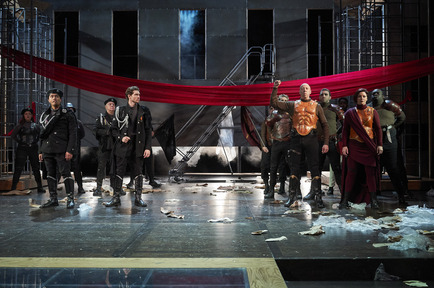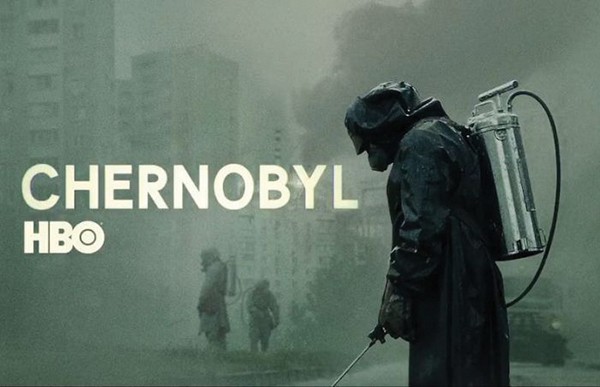The works of Shakespeare can never truly be understood through mere reading. Doing so would be missing the greatest extent of his work. Shakespeare wrote in a fashion where much of the power of his plays was gained through their performance. Through the acting of Shakespeare, actors are able to express the emotions and perspectives of the play, leading to a product that improves the overworked tripe of Shakespeare’s scripts. However, a poor theatrical demonstration of Shakespeare can be one of the most disappointing sights to behold. This is a mindset that the cast and crew of Great Lakes Theater’s production of Julius Caesar kept close to heart. The show was filled to the brim with a mixture of Shakespeare’s wording and theatrical charm. The theater went to some interesting extents to bring Shakespeare to life, and in the end, the attempts paid off. Through Great Lakes Theater’s costume design and directing, their production of Julius Caesar succeeded in bringing Shakespeare to life.
Costume Designer Leah Piehl uses a combination of past and modern attire to bring the ideas of Julius Caesar to life through clothing. Theater relies heavily on the visual flair of a performance, how the actors work off the items present with them on stage. If created well, the onstage wardrobe can create some interesting symbolism, a strategy constantly used by Piehl. For most of the play, the costumes stay within the time period the play is set in. People wear Roman garbs, such as tunics and togas. Everyone is dressed like they live in the Roman empire. The costumes are well designed and fully immerse the audience in the setting of the play, which is a nice choice. But as soon as Caesar is killed and war breaks out amongst the Roman legions, the costumes change. Mark Antony and Octavius’s armies now dress in World-War-I-Esque battle garb, while Brutus and Cassius’s armies remain in traditional Roman armor. What seems like an odd clash of time periods actually takes advantage of Shakespeare’s writings. In Julius Caesar, Shakespeare characterizes the conspirator’s army as the old nation, attempting to hold on to the glory of Rome. After all, that is the reason why Brutus killed Caesar. Mark Antony’s legion, on the other hand, takes the role of the new empire, ready to lead Rome in a new direction. The costumes they wear emphasize their call for a new Rome as they are based on more modern combat gear, while the conspirators remain in old-fashion Roman armor, the style they are trying to keep alive. Piehl’s ability to not only design costumes that look fantastic, but also function as symbolism for the power clash present in the story, demonstrates how excellent this production was.
Director Sarah Bruner uses her knowledge of directing Shakespeare to successfully bring Julius Caesar to the stage. The role of a director in a play is to bring the most out of her actors and to have the actors work in unity with the script and the set. Bruner does both of these things extremely well. All the actors in the play perform their roles with quality direction. They all express their characters well and truly embody the people Shakespeare was attempting to recreate. These performances scream of good directing, and thus Bruner must have done her job well. Along with interesting individual directing, Bruner succeeds in wide-scale directing, as well. Blocking, or actions of the characters on the stage is also done in a superb fashion. The actors constantly move in interesting ways, while still staying in the audience’s sight. This is most notable during Mark Antony’s monologue during Caesar’s funeral. While he cries compliments about Caesar to the Roman peasants, his movements are demonstrating his energy and sorrow. He is constantly climbing up and down the banister he is speaking on, motioning to Caesar’s body, and speaking amongst the people. And the peasants watching him are constantly moving, feeling animated rather than lifeless. Bruner’s blocking creates physical depictions of characters’ emotions through their movements, taking advantage of the visual aspects that theater is able to provide. Bruner’s directing, her blocking and acting instruction, is what transformed this group of assorted actors in costumes into a true embodiment of Julius Caesar.
The Great Lakes Theater is a combination of theatrical professionals who use their assorted skills to revive Shakespeare’s Julius Caesar on the stage. The wardrobe choices of Costume Designer Leah Piehl creates a symbolic representation of the power struggle within Rome that explodes after Caesar’s death. The acting direction and blocking of Director Sarah Bruner create performances that connect Shakespeare’s signature language with movement, making soliloquies more interesting to watch. Shakespeare is a hard playwright to cater to, but thanks to these two crew members, his words have been molded into life. The costumes and blocking of the play are what truly transformed the play into a celebration of Shakespeare’s delve into Roman history– transportation into to the times of ancient Rome, and the inevitable death of Julius Caesar.









